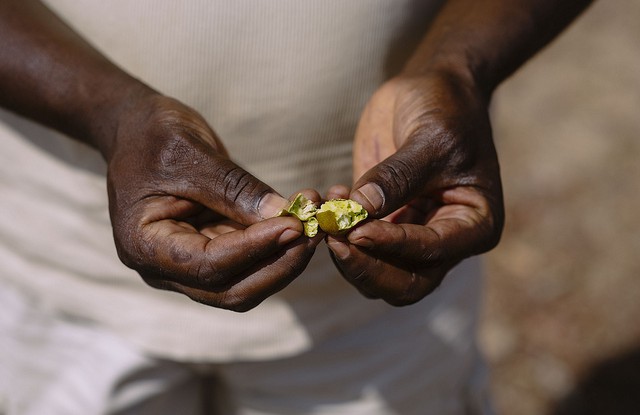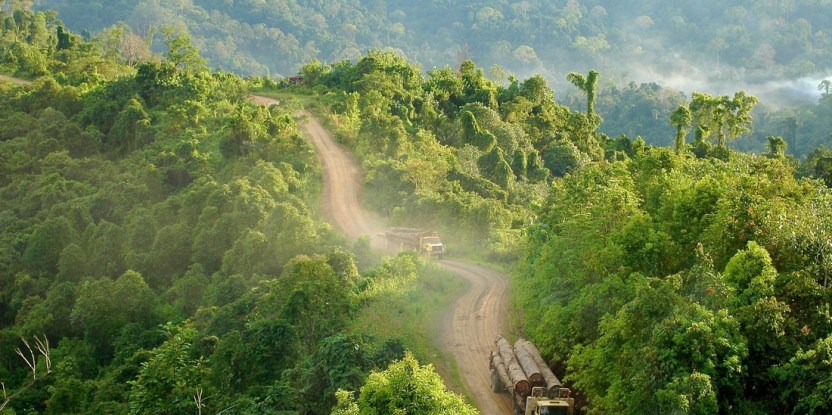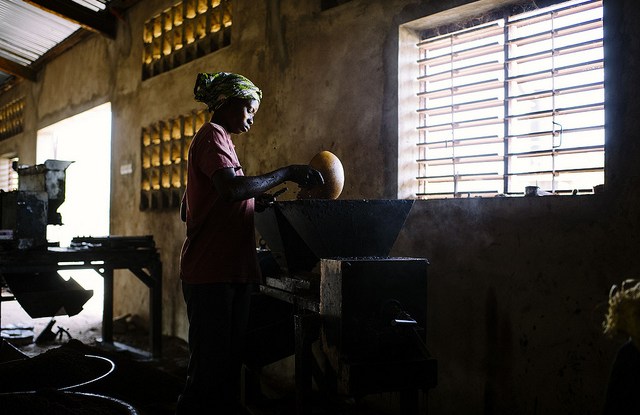
BOBO DIOULASSO, Burkina Faso—Global demand for Africa’s shea nuts is growing, but new research suggests that if rural women in West Africa who harvest the nuts are to benefit from the boom, it’s important that companies and development agents working with shea do not attempt to sideline local networks of shea wholesalers.
The study, undertaken in western Burkina Faso by researchers from the Center for International Forestry Research (CIFOR) and the French international agricultural research center (CIRAD), found that globalization of the shea market has greatly influenced the volume and the price of shea nut exports.
However, despite the fact that companies and NGOs would like to shorten the value chain to increase the benefits for the mostly women producers, so far globalization has had remarkably little impact on the organization of the regional shea nut supply chain in Burkina Faso.
They found that for the past 50 years, a handful of wholesalers in western Burkina Faso have controlled the many levels in the network of local shea nut traders who organize the harvest of nuts collected primarily by rural women in the country—and this has not changed.
“We demonstrate that wholesalers, despite their oligarchic organization, play an important role in the smooth functioning of the chain and in the sharing of benefits down the chain to the rural poor,” said Karen Rousseau, a co-author of the study.
This distinguishes the shea value chain from those of other tropical agricultural export commodities such as coffee, cocoa, banana, flowers and vegetables, which have all been heavily impacted by globalization.
“We contend that international traders and manufacturers have not succeeded in gaining control over the upstream supply chain of shea nuts,” the researchers wrote. And this is largely because of features inherent to the shea nut itself.
A UNIQUELY AFRICAN RESOURCE
Unlike other major tropical export commodities, shea is what is termed a non-timber forest product. Shea trees (Vitellaria paradoxa) are an important feature of agroforestry parklands in a semi-arid belt stretching 5,000 kilometers across Africa, from Senegal in the west to Sudan in the east. The tree is not planted by farmers in Burkina Faso, nor is it typically cultivated in monoculture—rather, farm families select, save and protect shea trees, which are often found in farm fields in association with other valuable parklands tree species such as the African locust bean (Parkia biglobosa).
The nuts themselves, long prized by local people for their high-quality oil used in cooking, as skin and hair cream, or for medicinal purposes, remain an important source of income for rural women in Africa’s Sudano-Sahelian region.
The difference now is that growing global demand for shea since 2000 has resulted in increased volumes of shea traded, driving up prices.
The booming market for shea has much to do with the growing global demand for fats and oils, particularly in emerging markets in Eastern Europe and the BRIC countries. Shea butter has similar chemical and physical properties to cocoa butter but costs less and—some argue—can improve the quality of chocolate by helping it maintain its texture, hardness and bright exterior, preventing the forming of fat bloom and increasing its heat resistance.
In their study, researchers focused on the value chain and the marketing of raw shea nuts for manufacturers of so-called Cocoa Butter Equivalent (CBE), regardless of the use to which the shea would be put after processing.
Half the shea produced in Burkina Faso is now exported. Of this, 90 percent is exported as unprocessed nuts to produce CBE; the remaining 10 percent is for use in the cosmetics and pharmaceutical industries. Between 2000 and 2005, the value of the raw nuts exported from Burkina Faso tripled, then increased again seven-fold between 2005 and 2012. Total exports of shea nuts (by weight) from Africa increased by 35 percent between 2000 and 2005.
That has been good news for rural women in Burkina Faso who produce the nuts, many of whom have few other sources of income.
INVALUABLE INCOME
“The wealth in rural areas is shea,” said Rabo Adama, who since 1993 has worked as an intermediary between large- and small-scale wholesalers in Bobo Dioulasso, Burkina Faso’s second-largest city and a major hub for the regional shea trade.
“The women harvest the kernels from the trees, sell them to small-scale buyers in rural areas, and that money tends to go directly towards education and other necessities for the children,” he continued. “And that is not always the case with the money that men earn.”
Although the nuts are sold for export, shea butter processed from shea nuts is still the main source of lipids in local diets in rural areas of the region. Rural women in Burkina Faso still keep a few kilograms of nuts for their own use, according to Adama. The price paid per kilogram, he said, fluctuates according to the global market price of cocoa butter.
Less than 10 percent of the shea exports from West Africa are of the butter itself, from nuts that have been processed locally, generally by women’s associations for niche cosmetic markets. While they represent a tiny fraction of the exports, these do tend to convey a positive image of a fair trade value chain, and are also the most visible internationally.
Far less well documented is the export of raw shea nuts that the researchers examined, a value chain that involves a huge number of rural poor across West Africa and that is crucial in supporting their livelihoods.
LOCAL IS KEY
The study shows clearly that the value chain of shea is different from other, more buyer-driven value chains. Large firms that transform the nuts into CBE may control the manufacturing process and the downstream portion of the value chain and thus control prices and margins, but wholesalers in Burkina Faso have maintained a grip on the upstream shea value chain.
The study provides development actors, government and NGOs with important insights into the structure and governance of the raw shea nut value chain for the agri-food market, which is supplied primarily by individual—and generally impoverished—rural women farmers.
The traders that link the farmers and the exporters cannot, the researchers argue, be seen only as “free riders.” Rather, they are inextricably bound to their shea traders’ networks and shea exporters, and retain relatively small margins with few of them involved in price speculation. They constitute useful and relevant actors in the shea value chain, creating value for this important and uniquely African resource at local and national levels.
Thus, they concluded, companies or NGOs dealing with shea should consider the role of the wholesalers in the chain and in the empowerment of the rural poor more carefully.
“Trying to bypass them even with the laudable goal of empowering marginal social groups entails a risk of excluding other rural poor who rely on their income from shea,” the researchers cautioned.
According to CIFOR’s Andrew Wardell, there is a need for additional research into shea value chains in Burkina Faso and Ghana.
“Research should monitor changes in the shea industry, to determine how new regulatory regimes governing export markets affect various actors in the shea value chain and how globalization is affecting the resource itself, as distinct from other drivers of degradation of the parkland agricultural systems in which shea trees are so important,” Wardell said.
For more information about this research, please contact Karen Rousseau at karen.rousseau@cirad.fr or Andrew Wardell at a.wardell@cgiar.org.
CIFOR’s research on shea nut value chains is supported in part by the CGIAR Research Program on Forests, Trees and Agroforestry.
We want you to share Forests News content, which is licensed under Creative Commons Attribution-NonCommercial-ShareAlike 4.0 International (CC BY-NC-SA 4.0). This means you are free to redistribute our material for non-commercial purposes. All we ask is that you give Forests News appropriate credit and link to the original Forests News content, indicate if changes were made, and distribute your contributions under the same Creative Commons license. You must notify Forests News if you repost, reprint or reuse our materials by contacting forestsnews@cifor-icraf.org.

